Land Use Transition and Regional Development Patterns Under Shared Socioeconomic Pathways: Evidence from Prefecture-Level Cities in China
Abstract
1. Introduction
2. Materials and Methods
2.1. Study Area
2.2. Data Source
2.3. Research Methodology
2.3.1. System Dynamics Model
2.3.2. Land Intensity
2.3.3. Population–Development–Environment Model
2.3.4. Neoclassical Model
Physical Capital Stock
Human Capital
2.3.5. BP Neural Network Model and Exponential Convergence Model
2.4. Parameter Settings
2.4.1. Parameter Settings of Population Projection in the SSPs
2.4.2. Parameter Settings for GDP Projection in the SSPs
3. Results
3.1. Comparison of Statistical Data and Projection Data
3.2. Population Projection for Prefecture-Level Cities in China
3.3. GDP Projection for Prefecture-Level Cities in China
3.4. Per Capita Income Projection for Prefecture-Level Cities in China
3.5. Spatial Distribution of Land Use and Efficiency
4. Discussion
5. Conclusions
- (1)
- SSP5 (conventional development) and SSP1 (sustainability) achieve high-income thresholds by 2025/2028 with intensive land development, while SSP3 (fragmentation) risks stagnation post-2037 accompanied by inefficient land use.
- (2)
- Spatial analysis identifies persistent dualism across the Hu Huanyong Line—83.6% of urban land expansion concentrates in eastern regions, whereas western areas exhibit 56% lower land productivity.
- (3)
- By 2050, regional land use efficiency differentials (0.3–4.3% Gross Domestic Product/capita growth) highlight challenges in balancing urban agglomeration and ecological conservation.
Author Contributions
Funding
Data Availability Statement
Conflicts of Interest
References
- O’Neill, B.; Kriegler, E.; Riahi, K.; Ebi, K.; Hallegatte, S.; Carter, T.; Mathur, R.; van Vuuren, D. A new scenario framework for climate change research: The concept of shared socioeconomic pathways. Clim. Change 2014, 122, 387–400. [Google Scholar] [CrossRef]
- Van Vuuren, D.; Kriegler, E.; O’Neill, B.; Ebi, K.; Riahi, K.; Carter, T.; Edmonds, J.; Hallegatte, S.; Kram, T.; Mathur, R.; et al. A new scenario framework for Climate Change Research: Scenario matrix architecture. Clim. Change 2014, 122, 373–386. [Google Scholar] [CrossRef]
- Dellink, R.; Chateau, J.; Lanzi, E.; Magné, B. Long-term economic growth projections in the Shared Socioeconomic Pathways. Glob. Environ. Change Hum. Policy Dimens. 2017, 42, 200–214. [Google Scholar] [CrossRef]
- Leimbach, M.; Kriegler, E.; Roming, N.; Schwanitz, J. Future growth patterns of world regions—A GDP scenario approach. Glob. Environ. Change Hum. Policy Dimens. 2017, 42, 215–225. [Google Scholar] [CrossRef]
- Jiang, T.; Zhao, J.; Cao, L.; Wang, Y.; Su, B.; Jing, C.; Wang, R.; Gao, C. Projection of national and provincial economy under the shared socioeconomic pathways in China. Clim. Change Res. 2018, 14, 50–58. [Google Scholar] [CrossRef]
- Guo, A.; Ding, X.; Zhong, F.; Cheng, Q.; Huang, C. Predicting the Future Chinese Population using Shared Socioeconomic Pathways, the Sixth National Population Census, and a PDE Model. Sustainability 2019, 11, 3686. [Google Scholar] [CrossRef]
- Wang, D.; Luo, H.; Grunder, O.; Lin, Y.; Guo, H. Multi-step ahead electricity price forecasting using a hybrid model based on two-layer decomposition technique and BP neural network optimized by firefly algorithm. Appl. Energy 2017, 190, 390–407. [Google Scholar] [CrossRef]
- Ding, X.; Zhong, F.; Mao, J.; Song, X.; Huang, C. Provincial urbanization projected to 2050 under the shared socioeconomic pathways in China. Adv. Clim. Change Res. 2018, 14, 392. [Google Scholar] [CrossRef]
- Dong, N.; You, L.; Cai, W.; Li, G.; Lin, H. Land use projections in China under global socioeconomic and emission scenarios: Utilizing a scenario-based land-use change assessment framework. Glob. Environ. Change-Hum. Policy Dimens. 2018, 50, 164–177. [Google Scholar] [CrossRef]
- Glawe, L.; Wagner, H. China in the middle-income trap? China Econ. Rev. 2020, 60, S1043951X19300033. [Google Scholar] [CrossRef]
- Yao, Y. Chapter 7—The Chinese Growth Miracle. In Handbook of Economic Growth; Aghion, P., Durlauf, S.N., Eds.; Elsevier: Amsterdam, The Netherlands, 2014; Volume 2, pp. 943–1031. [Google Scholar]
- Woo, W. China Meets the Middle-Income Trap: The Large Potholes in the Road to Catching-Up. J. Chin. Econ. Bus. Stud. 2012, 10, 313–336. [Google Scholar] [CrossRef]
- Cai, F. Is There a ’Middle-Income Trap’? Theories, Experiences and Relevance to China. China World Econ. 2012, 20, 49–61. [Google Scholar] [CrossRef]
- Felipe, J.; Abdon, A.; Kumar, U. Tracking the Middle-Income Trap: What is it, Who is in it, and Why? In ERN: Consumption; Saving (Consumption) (Topic); Levy Economics Institute: Annandale-on-Hudson, NY, USA, 2012. [Google Scholar]
- Barro, R.; Sala-i-Martin, X. Economic Growth, 2nd ed.; MIT Press: Cambridge, MA, USA, 2003. [Google Scholar]
- Li, Z.; Zhou, C.; Yang, X.; Chen, X.; Meng, F.; Lu, C.; Pan, T.; Qi, W. Urban landscape extraction and analysis in the mega-city of China’s coastal regions using high-resolution satellite imagery: A case of Shanghai, China. Int. J. Appl. Earth Obs. Geoinf. 2018, 72, 140–150. [Google Scholar] [CrossRef]
- Jiang, T.; Wang, Y.; Yuan, J.; Chen, Y.; Gao, X.; Jing, C.; Wang, G.; Wu, X.; Zhao, C. Projection of population and economy in the Belt and Road countries (2020–2060). Clim. Change Res. 2018, 14, 155–164. [Google Scholar] [CrossRef]
- Zhou, J.; Jiang, T.; Wang, Y.; Su, B.; Tao, H.; Qin, J.; Zhai, J. Spatiotemporal variations of aridity index over the Belt and Road region under the 1.5 °C and 2.0 °C warming scenarios. J. Geogr. Sci. 2020, 30, 37–52. [Google Scholar] [CrossRef]
- Huang, J.; Qin, D.; Jiang, T.; Wang, Y.; Feng, Z.; Zhai, J.; Cao, L.; Chao, Q.; Xu, X.; Wang, G.; et al. Effect of Fertility Policy Changes on the Population Structure and Economy of China: From the Perspective of the Shared Socioeconomic Pathways. Earths Future 2019, 7, 250–265. [Google Scholar] [CrossRef]
- Jiang, T.; Zhao, J.; Jing, C.; Cao, L.; Wang, Y.; Sun, H.; Wang, A.; Huang, J.; Su, B.; Wang, R. National and Provincial Population Projected to 2100 Under the Shared Socioeconomic Pathways in China. Clim. Change Res. 2017, 13, 128. [Google Scholar] [CrossRef]
- Yao, S.; Li, Y.; Jiang, H.; Wang, X.; Ran, Q.; Ding, X.; Wang, H.; Ding, A. Predicting Land Use Changes under Shared Socioeconomic Pathway–Representative Concentration Pathway Scenarios to Support Sustainable Planning in High-Density Urban Areas: A Case Study of Hangzhou, Southeastern China. Buildings 2024, 14, 2165. [Google Scholar] [CrossRef]
- Wang, Z.; Li, X.; Mao, Y.; Li, L.; Wang, X.; Lin, Q. Dynamic simulation of land use change and assessment of carbon storage based on climate change scenarios at the city level: A case study of Bortala, China. Ecol. Indic. 2022, 134, 108499. [Google Scholar] [CrossRef]
- Lutz, W. Population, Development, Environment: Understanding Their Interactions in Mauritius; Springer: Berlin/Heidelberg, Germany, 1994. [Google Scholar]
- Meng, L.G.; Li, C.L.; Hu, G. Predictions of China’s population structure based on the PDF model. Zhongguo Renkou Ziyuan Yu Huan Jing/China Popul. Resour. Environ. 2014, 24, 132–141. [Google Scholar] [CrossRef]
- Gallopin, G.; Raskin, P. Global Sustainability: Bending the Curve; Routledge: England, UK, 2002. [Google Scholar]
- Kemp-Benedict, E.; Heaps, C.; Raskin, P. Global Scenario Group Futures; Technical Notes; Stockholm Environmeny Institute: Stockholm, Sweden, 2002. [Google Scholar]
- Nakicenovic, N.; Alcamo, J.; Davis, G.; Vries, B.d.; Fenhann, J.V.; Gaffin, S.R.; Gregory, K.; Grubler, A.; Jung, T.Y.; Kram, T.; et al. Special Report on Emissions Scenarios: A Special Report of Working Group III of the Intergovernmental Panel on Climate Change; Cambridge University Press: Cambridge, MA, USA, 2000. [Google Scholar]
- Huang, Y.; Ruoen, R.; Liu, X. Capital stock estimates in Chinese manufacturing by perpetual inventory approach. China Econ. Q. 2002, 1, 377–396. [Google Scholar]
- Lejour, A.; Veenendaal, P.; Verweij, G.; van Leeuwen, N. Worldscan; a Model for International Economic Policy Analysis; CPB Netherlands Bureau for Economic Policy Analysis: Den Haag, The Netherlands, 2006. [Google Scholar]
- Rumelhart, D.; McClelland, J.; Group, P.R. Parallel Distributed Processing, Volume 1: Explorations in the Microstructure of Cognition: Foundations; MIT Press: Cambridge, MA, USA, 1986. [Google Scholar]
- Kemp-Benedict, E. Downscaling global income scenarios assuming institutional convergence or divergence. Glob. Environ. Change 2012, 22, 877–883. [Google Scholar] [CrossRef]
- McKibbin, W.; Pearce, D.; Stegman, A. Climate change scenarios and long term projections. Clim. Change 2009, 97, 23–47. [Google Scholar] [CrossRef]
- Mccombie, J.; Thirlwall, A. Economic Growth and the Balance-of-Payments Constraint; Macmillan London Ltd.: London, UK; Basingstoke, UK, 1993. [Google Scholar]
- Solow, R. A Contribution to the Theory of Economic Growth. Q. J. Econ. 1956, 70, 65–94. [Google Scholar] [CrossRef]
- Goldsmith, R. A Perpetual Inventory of National Wealth. In Studies in Income and Wealth; National Bureau of Economic Research, Inc.: Cambridge, MA, USA, 1951; Volume 14, pp. 5–73. [Google Scholar]
- Ke, S.; Xiang, J. Estimation of the Fixed Capital Stocks in Chinese Cities for 1996–2009. Stat. Res. 2012, 7, 19–24. [Google Scholar] [CrossRef]
- Zhang, J. Estimation of China’s provincial capital stock (1952–2004) with applications. J. Chin. Econ. Bus. Stud. 2008, 6, 177–196. [Google Scholar] [CrossRef]
- Kc, S.; Lutz, W. The human core of the shared socioeconomic pathways: Population scenarios by age, sex and level of education for all countries to 2100. Glob. Environ. Change 2017, 42, 181–192. [Google Scholar] [CrossRef]
- Guo, L.; Che, S. The Effect of China’s Labor Participation Rate and Demographic Dividend on Economic Growth. J. Cent. Univ. Financ. Econ. 2011, 9, 47–53. [Google Scholar]
- Rumelhart, D.; Hinton, G.; Williams, R. Learning representations by back-propagating errors. Nature 1986, 323, 533–536. [Google Scholar] [CrossRef]
- Johansson, Å.; Guillemette, Y.; Murtin, F.; Turner, D.; Nicoletti, G.; de la Maisonneuve, C.; Bagnoli, P.; Bousquet, G.; Spinelli, F. Long-Term Growth Scenarios; OECD Publishing: Paris, France, 2013. [Google Scholar]
- Wang, J.; Ge, Y. Population Trends in China under the Universal Two-Child Policy. Popul. Res. 2016, 40, 3–21. [Google Scholar]
- Nielsen, L. Classifications of Countries Based on Their Level of Development: How it is Done and How it Could Be Done. IMF Work. Pap. 2011, 11, 46. [Google Scholar] [CrossRef]
- Bank, T.W. World Bank Country and Lending Groups. Available online: http://data.worldbank.org/about/country-and-lending-groups (accessed on 5 November 2024).
- Gill, I.; Kharas, H. An East Asian Renaissance: Ideas for Economic Growth; The World Bank Group: Washington, DC, USA, 2007. [Google Scholar]
- Attanasio, O.; Picci, L.; Scorcu, A. Saving, investment and growth: A macroeconomic analysis with a panel of countries. Rev. Econ. Stat. 2000, 82, 182–211. [Google Scholar] [CrossRef]
- O’Neill, B.; Kriegler, E.; Ebi, K.; Kemp-Benedict, E.; Riahi, K.; Rothman, D.; van Ruijven, B.; van Vuuren, D.; Birkmann, J.; Kok, K.; et al. The roads ahead: Narratives for shared socioeconomic pathways describing world futures in the 21st century. Glob. Environ. Change 2017, 42, 169–180. [Google Scholar] [CrossRef]
- Aghion, P.; Howitt, P.; Brant-Collett, M.; García-Peñalosa, C. Endogenous Growth Theory; MIT Press: Cambridge, MA, USA, 1998. [Google Scholar]
- Seto, K.C.; Güneralp, B.; Hutyra, L.R. Global Urban Expansion and Its Implications for Land Use. Proc. Natl. Acad. Sci. USA 2012, 109, 16083–16088. [Google Scholar] [CrossRef] [PubMed]
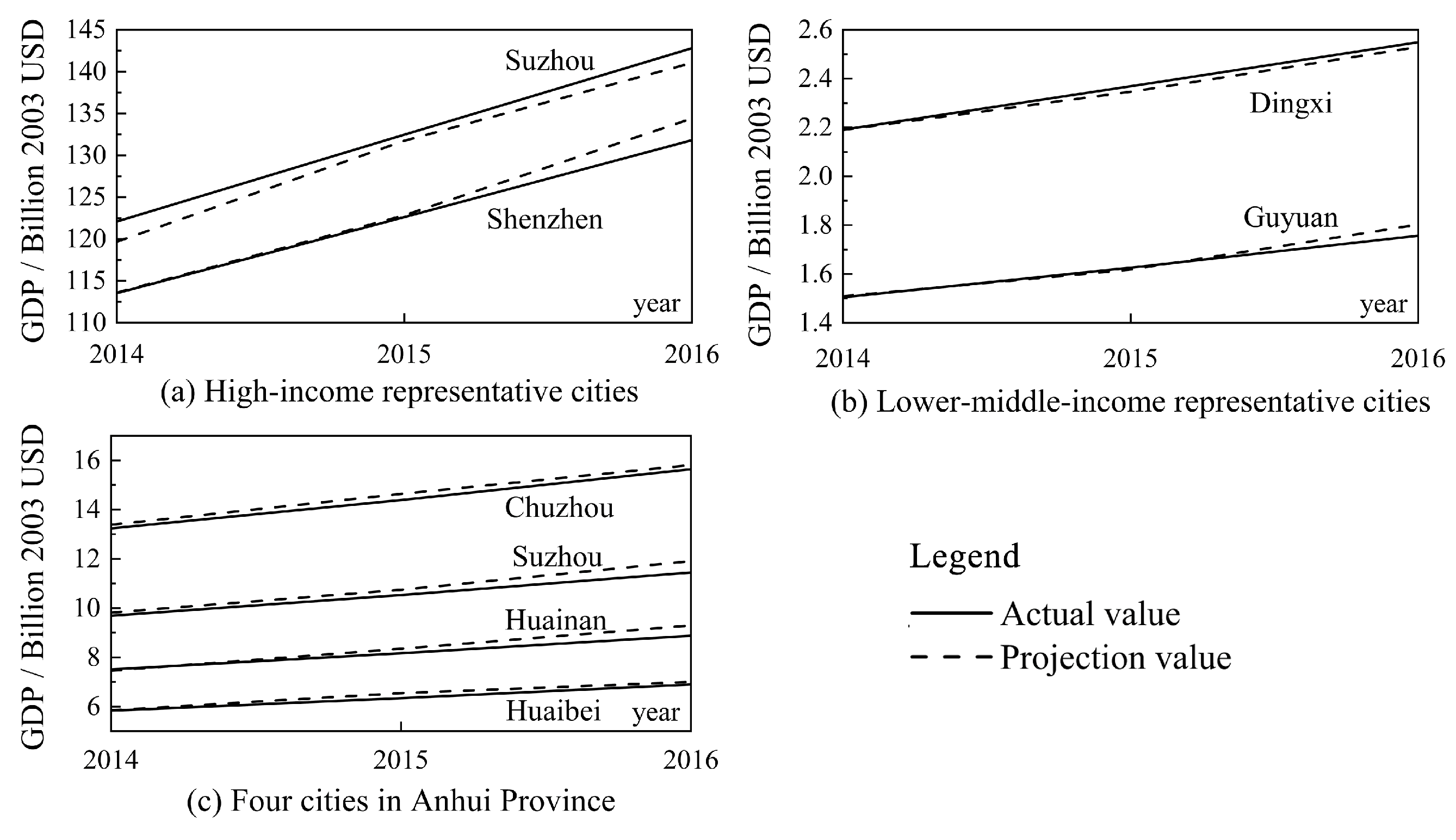
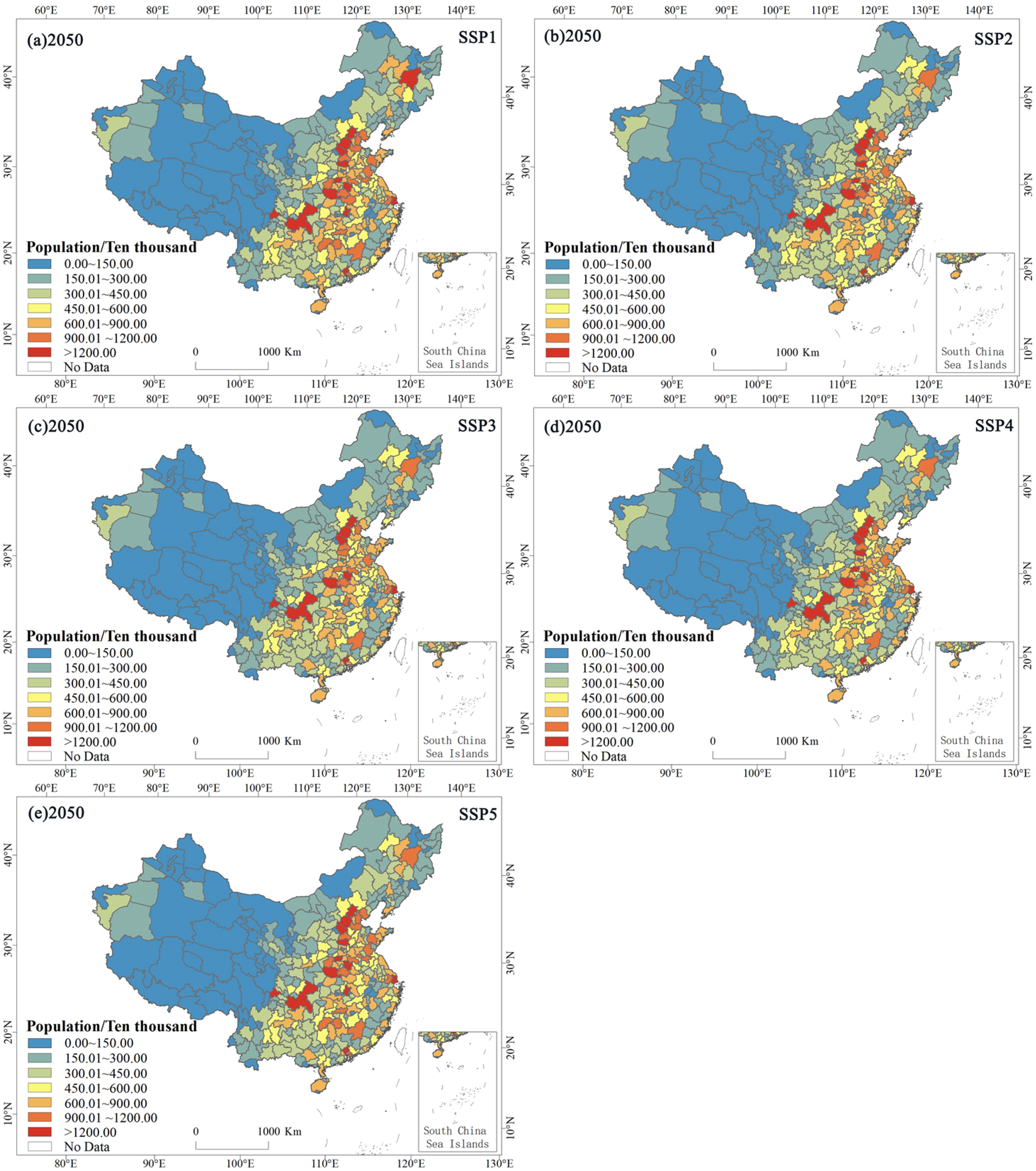

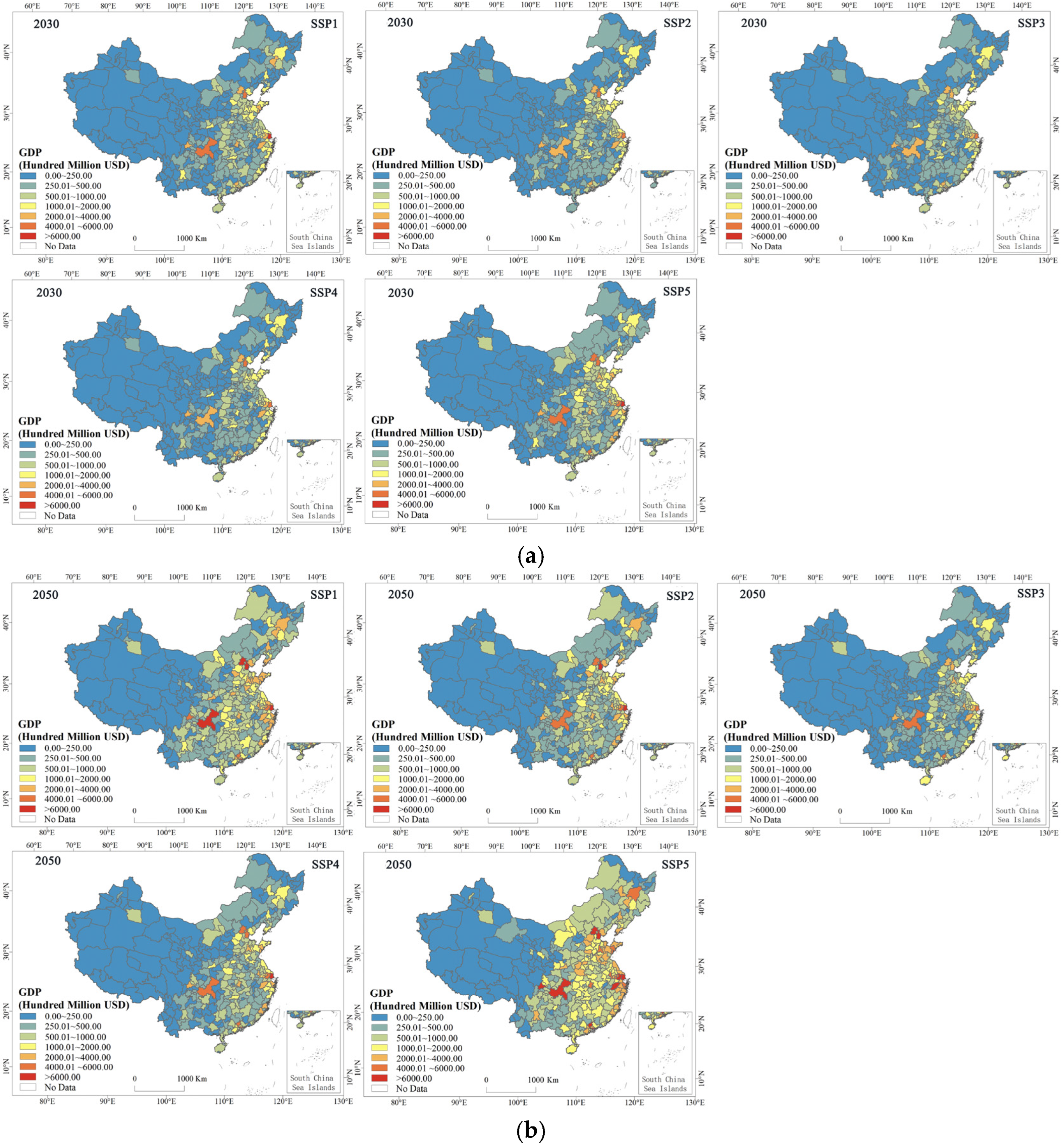
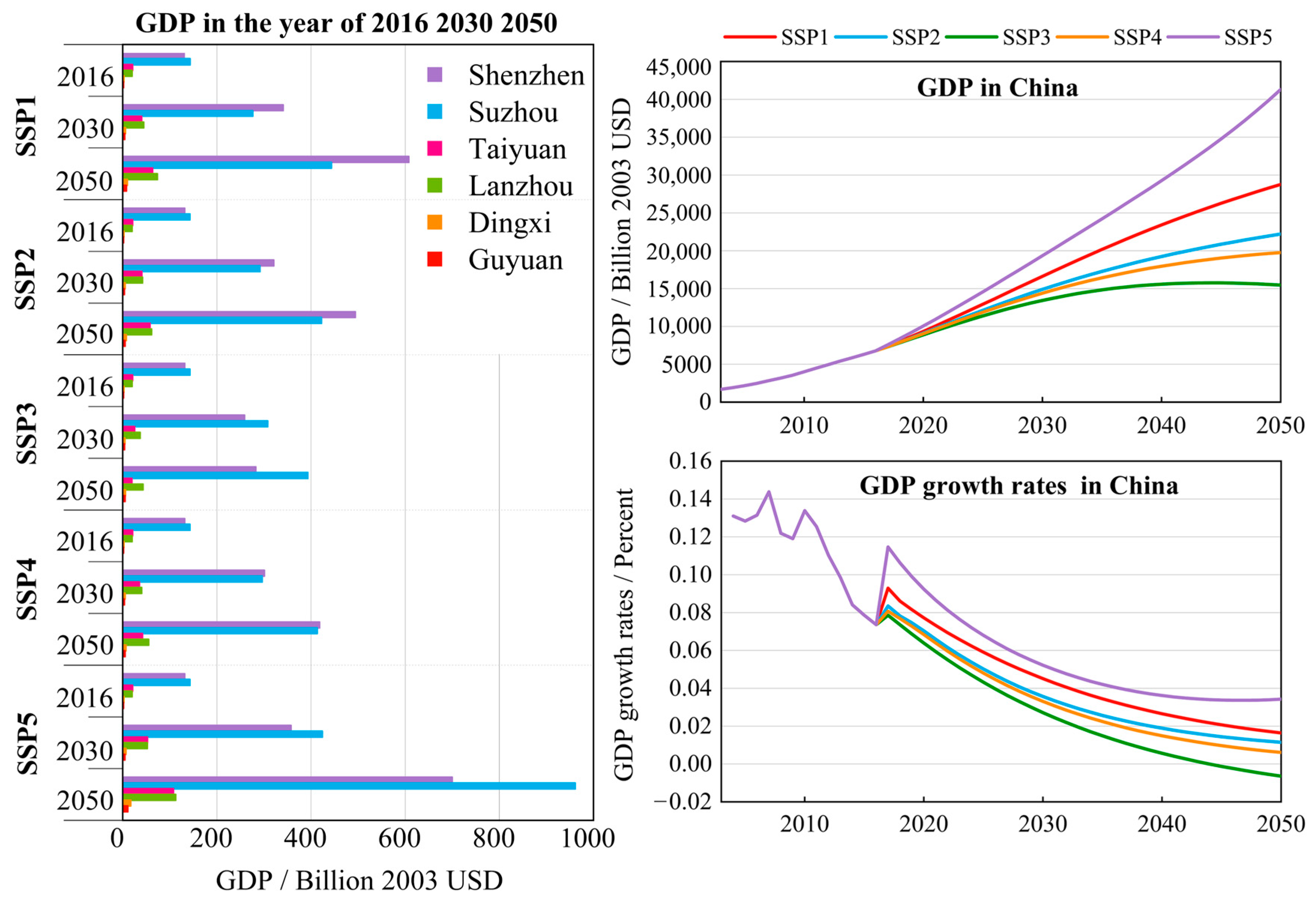
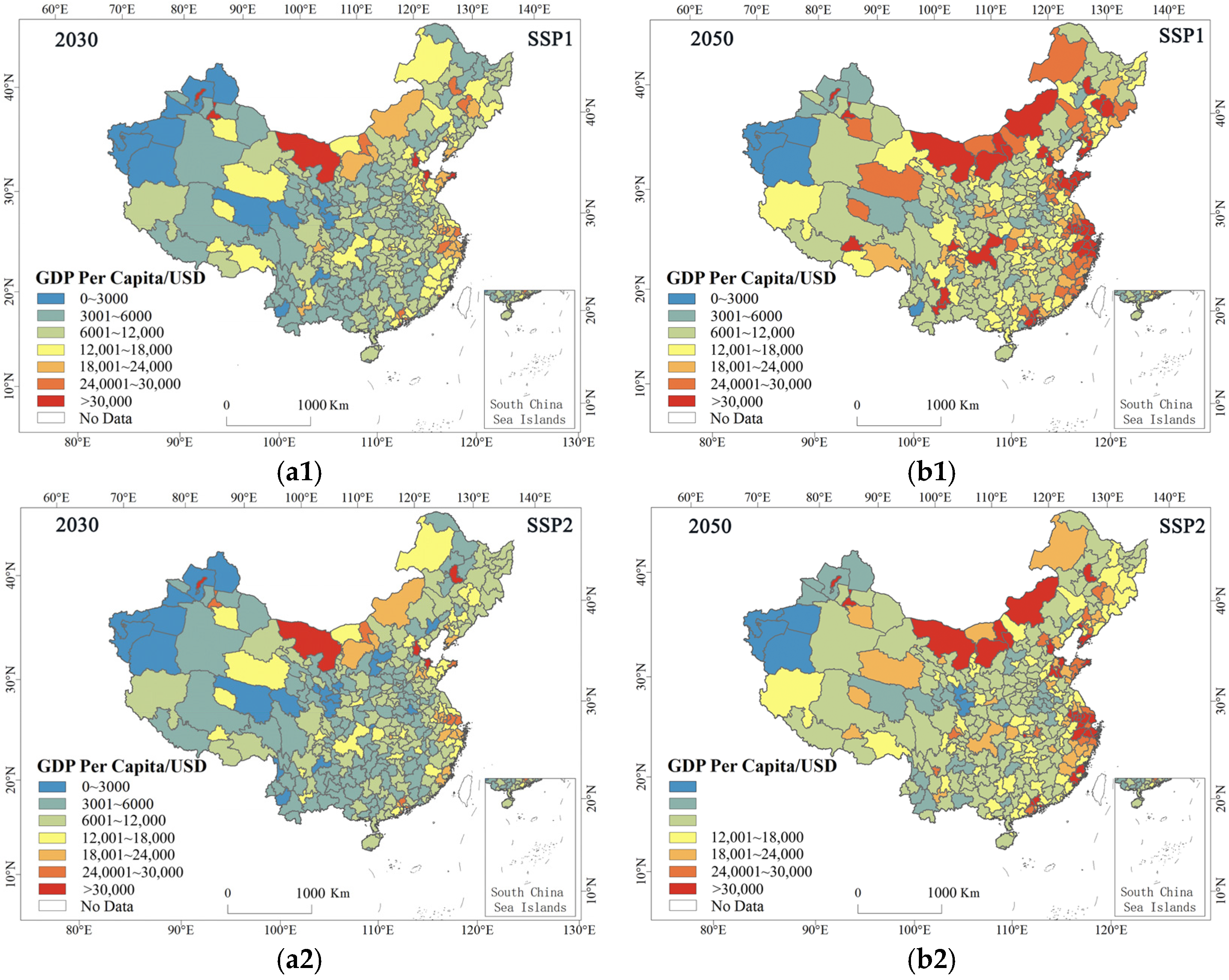
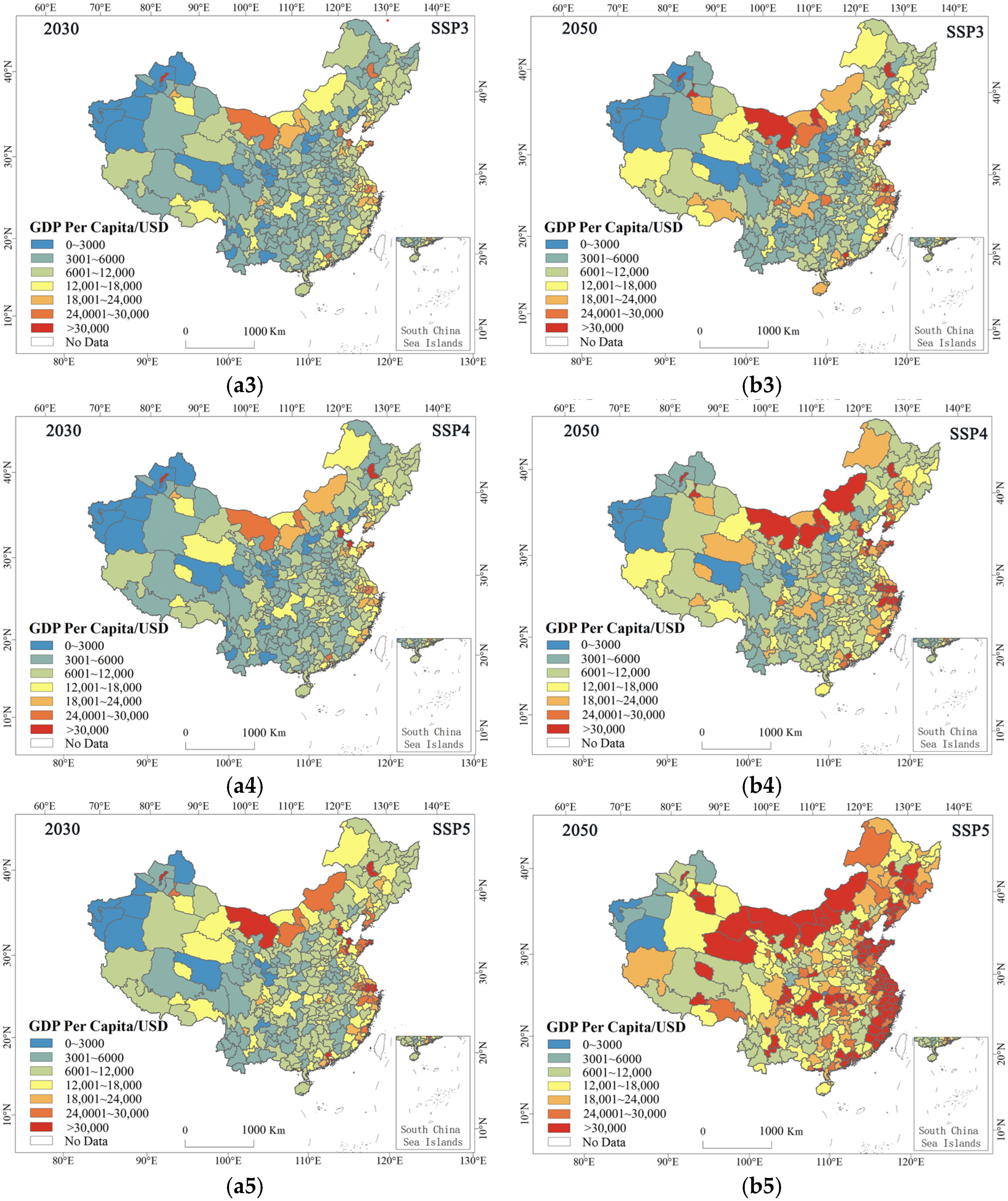


| Narratives | Fertility | Mortality | Life Expectancy | Migration Speed Between Urban and Rural Areas |
|---|---|---|---|---|
| SSP1 | High | Low | High | Fast |
| SSP2 | Medium | Medium | Medium | Medium |
| SSP3 | Low | High | Low | Slow |
| SSP4 | Medium-Low | Medium | Medium | High-income provinces, medium Lower middle-income provinces, fast |
| SSP5 | Medium-High | Low | High | Fast |
| Total Fertility | 2015 | 2020 | 2025 | 2030 | 2035 | 2040 | 2045 | 2050 |
|---|---|---|---|---|---|---|---|---|
| Low | 1.52 | 1.632 | 1.632 | 1.54 | 1.54 | 1.54 | 1.54 | 1.54 |
| Medium-Low | 1.52 | 1.632 | 1.632 | 1.632 | 1.632 | 1.632 | 1.632 | 1.632 |
| Medium | 1.6 | 1.8 | 1.8 | 1.8 | 1.8 | 1.8 | 1.8 | 1.8 |
| Medium-High | 1.68 | 2.04 | 2.04 | 2.04 | 2.04 | 2.04 | 2.04 | 2.04 |
| High | 2.04 | 2.07 | 2.1 | 2.1 | 2.1 | 2.1 | 2.1 | 2.1 |
| Economic Parameter | Parameter Type | SSP1 | SSP2 | SSP3 | SSP4 | SSP5 |
|---|---|---|---|---|---|---|
| Actual investment in fixed assets | Convergent target | 1.005 | 1.005 | 0.98 | 0.98 | 1.05 |
| Medium-Low | Convergence years | 50 | 35 | 50 | 75 | 50 |
| Labor participation rate | Convergent target | 0.63 | 0.63 | 0.60 | 0.65 | 0.73 |
| Medium-High | Convergence years | 35 | 50 | 50 | 75 | 50 |
| Years of education | Convergent target | 1.005 | 1.005 | 0.98 | 0.98 | 1.05 |
| Convergence years | 50 | 35 | 50 | 75 | 50 | |
| Employed population | Convergent target | 1.005 | 1.005 | 0.98 | 0.98 | 1.05 |
| Convergence years | 50 | 35 | 50 | 75 | 50 |
| GDP (Hundred Million USD) | Population (Ten Thousand) | Per Capita GDP (USD) | Per Capita Income Level | Province | |
|---|---|---|---|---|---|
| Shenzhen | 2934.62 | 1077 | 27,248.06 | High | Guangdong |
| Suzhou | 2329.78 | 1060 | 21,979.05 | High | Jiangsu |
| Taiyuan | 444.97 | 429 | 10,372.18 | Upper-middle | Shanxi |
| Lanzhou | 340.88 | 401 | 8500.76 | Upper-middle | Gansu |
| Dingxi | 49.84 | 278.98 | 1786.66 | Lower-middle | Gansu |
| Guyuan | 36.11 | 122.04 | 2959.19 | Lower-middle | Ningxia |
| 2003–2010 | 2011–2020 | 2021–2030 | 2031–2040 | 2041–2050 | |
|---|---|---|---|---|---|
| SSP1 | 0.130 | 0.091 | 0.058 | 0.034 | 0.020 |
| SSP2 | 0.130 | 0.088 | 0.049 | 0.025 | 0.014 |
| SSP3 | 0.130 | 0.086 | 0.042 | 0.014 | −0.002 |
| SSP4 | 0.130 | 0.087 | 0.047 | 0.022 | 0.010 |
| SSP5 | 0.130 | 0.098 | 0.067 | 0.042 | 0.034 |
| 2004–2010 | 2011–2020 | 2021–2030 | 2031–2040 | 2041–2050 | |
|---|---|---|---|---|---|
| SSP1 | 0.120 | 0.097 | 0.061 | 0.037 | 0.026 |
| SSP2 | 0.120 | 0.096 | 0.051 | 0.028 | 0.020 |
| SSP3 | 0.120 | 0.095 | 0.044 | 0.017 | 0.005 |
| SSP4 | 0.120 | 0.096 | 0.049 | 0.025 | 0.016 |
| SSP5 | 0.120 | 0.100 | 0.073 | 0.046 | 0.042 |
Disclaimer/Publisher’s Note: The statements, opinions and data contained in all publications are solely those of the individual author(s) and contributor(s) and not of MDPI and/or the editor(s). MDPI and/or the editor(s) disclaim responsibility for any injury to people or property resulting from any ideas, methods, instructions or products referred to in the content. |
© 2025 by the authors. Licensee MDPI, Basel, Switzerland. This article is an open access article distributed under the terms and conditions of the Creative Commons Attribution (CC BY) license (https://creativecommons.org/licenses/by/4.0/).
Share and Cite
Zhang, X.; Yang, M.; Guo, R.; Li, Y.; Zhong, F. Land Use Transition and Regional Development Patterns Under Shared Socioeconomic Pathways: Evidence from Prefecture-Level Cities in China. Land 2025, 14, 454. https://doi.org/10.3390/land14030454
Zhang X, Yang M, Guo R, Li Y, Zhong F. Land Use Transition and Regional Development Patterns Under Shared Socioeconomic Pathways: Evidence from Prefecture-Level Cities in China. Land. 2025; 14(3):454. https://doi.org/10.3390/land14030454
Chicago/Turabian StyleZhang, Xiaodong, Mingjie Yang, Rui Guo, Yaolong Li, and Fanglei Zhong. 2025. "Land Use Transition and Regional Development Patterns Under Shared Socioeconomic Pathways: Evidence from Prefecture-Level Cities in China" Land 14, no. 3: 454. https://doi.org/10.3390/land14030454
APA StyleZhang, X., Yang, M., Guo, R., Li, Y., & Zhong, F. (2025). Land Use Transition and Regional Development Patterns Under Shared Socioeconomic Pathways: Evidence from Prefecture-Level Cities in China. Land, 14(3), 454. https://doi.org/10.3390/land14030454







